For Canberra United, the 2023/24 A-League Women season has not been one to write home about thus far, with them losing three of their opening five matches and only tasting victory for the first time at the weekend when Brisbane Roar Women visited McKellar Park. They do still have games in hand, with them having played two fewer matches than most other sides have, so there is no need to worry yet. However, there is no doubt that they would have hoped for a better start to the campaign, given that they finished last season in fifth place and would have been aiming to improve on that this time around.
Amongst the disappointment of their initial results, though, there have been several positives for them and their fans to enjoy, including the form of midfielder Vesna Milivojević. She might have only signed for the team in the build-up to the 2022/23 campaign, having spent two years in Germany and Serbia before that, but she has quickly established herself as a player to watch in the Australian women’s game and someone who never fails to add sparkle to a performance.
This tactical analysis will take a closer look at what makes the 21-year-old so vital for her team, highlighting how she has developed her individual qualities and detailing what she adds to their tactics. The scout report will look at what she offers in all three areas of the field and will show why an injury that she sustained during the win against Brisbane could prove to be detrimental to her side’s hopes of climbing the table.
Attacking threat
When watching Vesna Milivojević this season, what has been increasingly noticeable is the expanded role that she has been given, with her operating mainly in the midfield last season but tending to be deployed in the forward line during the current one.
Given how well she did in the central third last season, it might seem like a strange move to use her in a different way, but it is a tactical decision that has worked out for Canberra United for a number of reasons.

The primary reason she has been deployed higher up the field is because it allows Canberra to win the ball in more advanced areas, with Milivojević thriving at disrupting play and closing opponents down last season. It was one of the reasons that she became such a vital cog in the Canberra machine, with their tactics revolving around pressing opponents and winning the ball as early as possible once it has been lost.
The result of this positional change has been very positive for Canberra, with them this season tending to regain possession inside the opposing third, and Milivojević has had no problem converting her pressing abilities into the forward role. In this case, she has got tight to Brisbane defender Leah Scarpelli, preventing her from playing the ball up the field and instead limiting her to only moving the ball back inside her. However, by doing so, Scarpelli sends the ball directly into the path of the waiting Canberra captain, Michelle Heyman, with Canberra’s ability to apply pressure, leading to them now being in a position to launch an attack of their own.
On this occasion, the chance didn’t come off as the experienced former Australia striker’s pass back towards Milivojević was made as the latter was in an offside position. Still, the impact of this increased pressure is clear to see, and it shows how Canberra have benefitted from having her in these advanced positions.
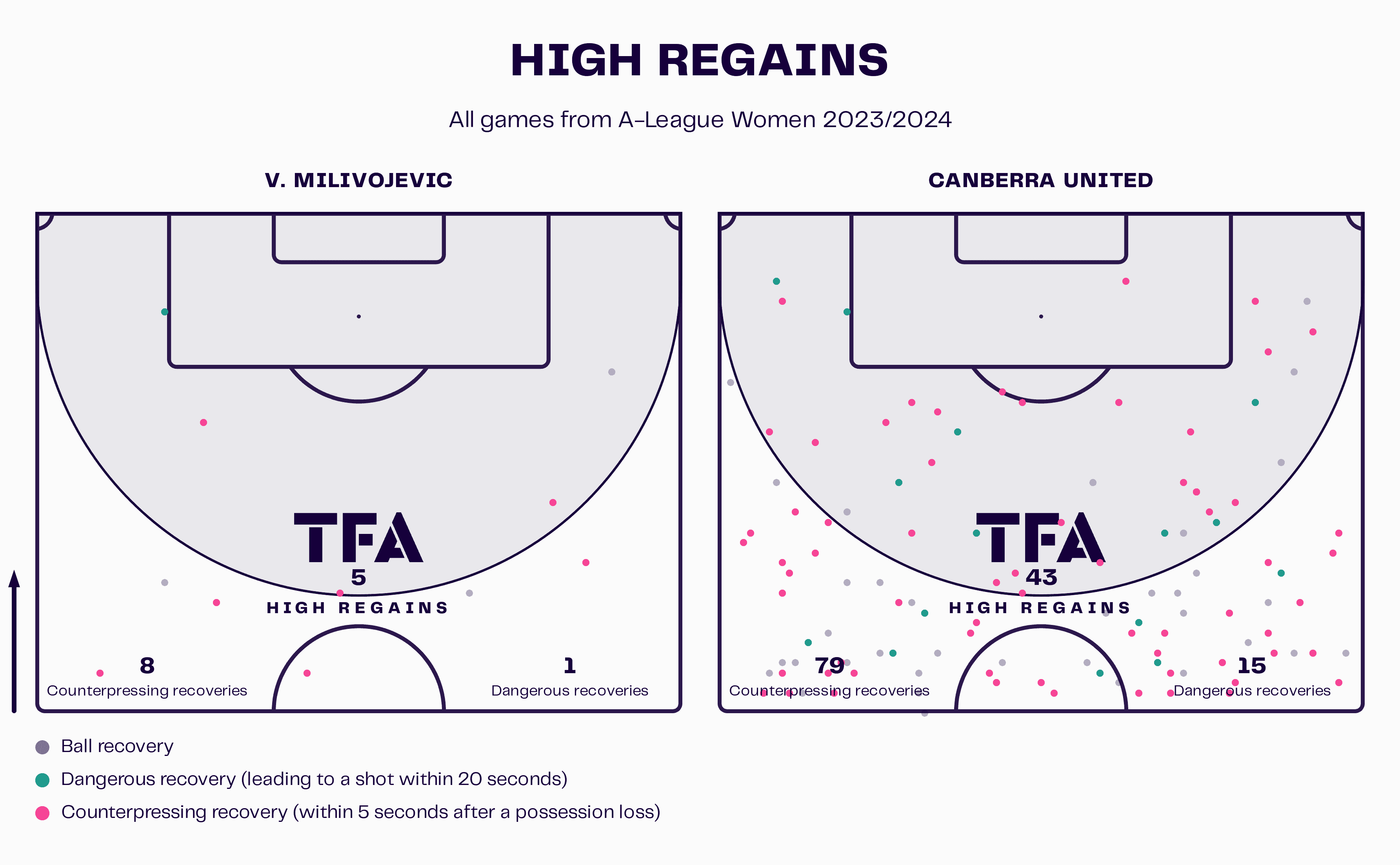
This has not been the only time that Canberra were able to regain the ball high up the field, with them making 43 high recovers, 79 counterpressing recoveries and 15 dangerous recoveries, and that highlights just how dangerous they are and why teams are often rushed into moving the ball out of danger when coming up against them.
However, what is important to note is the impact that Milivojević has had on that being possible, with her contributing five high regains, eight counterpressing recoveries and one dangerous recovery, and that conveys just how effective she has been this season and why having her in these advanced positions is really allowing Canberra to play on the front foot and to ask their opponents some really difficult questions.
With that in mind, any injury that she might have picked up and any time that the team will now be without her for will hurt them as they try to recover from their slow start and to make their way back up the table.

Whilst that last situation showed Milivojević playing alongside Heyman at the top of the pitch, what has been more common is for the latter to drop back into holes behind the attack and for the former to lead the line on her own.
Given that Milivojević is a midfielder by trade and Heyman a striker, this again might sound strange, but there is a very clever reason for it, with head coach Njegosh Popovich looking to create gaps inside the opposing thirds, and so inverting the two players in order to tempt the defenders out of position. Brisbane were one of those that have fallen into these traps, with the back line following Heyman here and allowing Milivojević to run into the open territory behind them.
Once this shape has been created, all it then takes is for the ball to be passed into Milivojević’s path, and Canberra are through on goal and the fact that both her and Heyman worked so well together in these situations was one reason that Canberra secured a dominant victory and Milivojević a hat-trick, taking her tally to eight for the season, leaving her top of the goal standings at the time of writing and seeing her surpass her tally for last season of six.
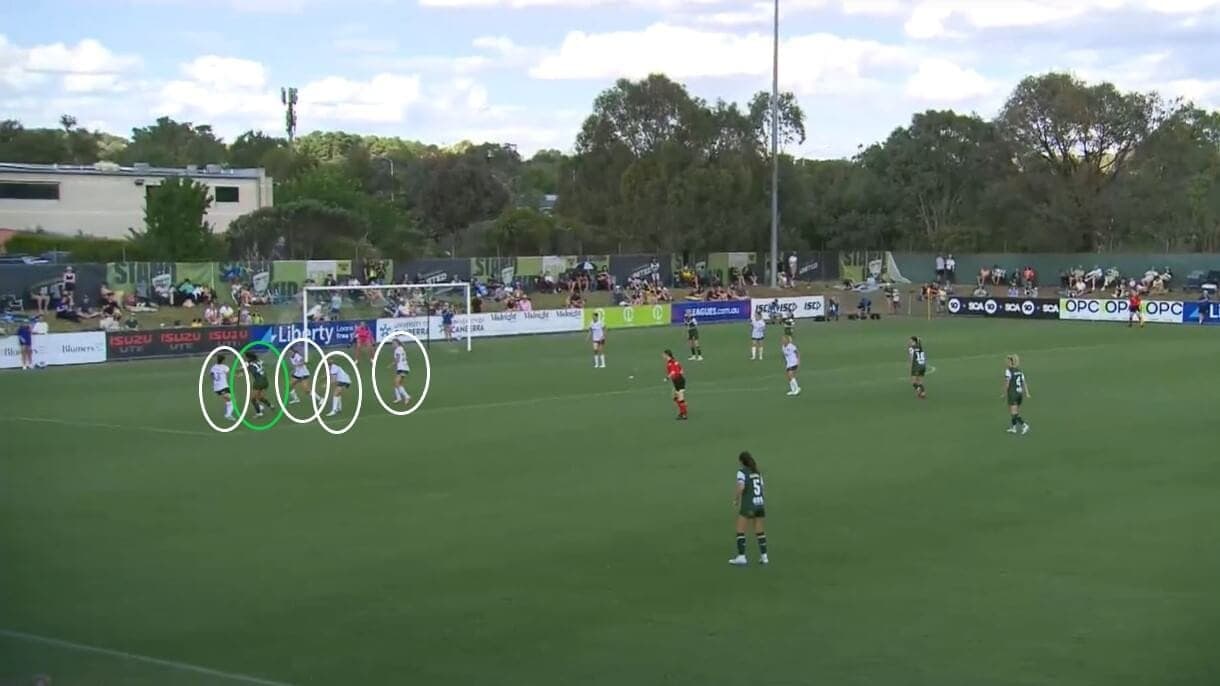
However, given that Canberra have tended to set up in a 4-4-2 shape during Popovich’s time at the helm, Milivojević has not always been the focal point of the team. Instead, it needs to show the same goal threat from different areas of the field.
In this case, she is positioned just off-centre, and her angle to goal is a tough one; it has been made even harder by the fact that Newcastle Jets Women have surrounded her with four players in recognition of the danger she poses and in an attempt to limit it.
What should happen here is that one of Zoe Karapidis, Josephine Wilson, Cassidy Davis or Lauren Allan should make a tackle and win the ball back for Newcastle, bringing the danger to an end, but what actually occurs is that Milivojević twists her way between them and fashions a gap through which she can test goalkeeper Isobel Nino, with her finding the back of the net here to really demonstrate the increased goal threat that she poses now that she is playing in these forward areas.
There is an argument that the defending from Newcastle here was poor and that they should have prevented the chance from coming about, but sometimes, the attacker needs to be applauded for their control of the ball and the way that they shook off those defenders closest to them, and this was undoubtedly one of those moments.
Patrolling the midfield
The fact that she has become such a dangerous attacker does not mean she has no longer been needed in the central third, though. There have been plenty of occasions when she has been required to drop back into roles that she formerly occupied in the team, both when Canberra United have had the ball and when they have not.
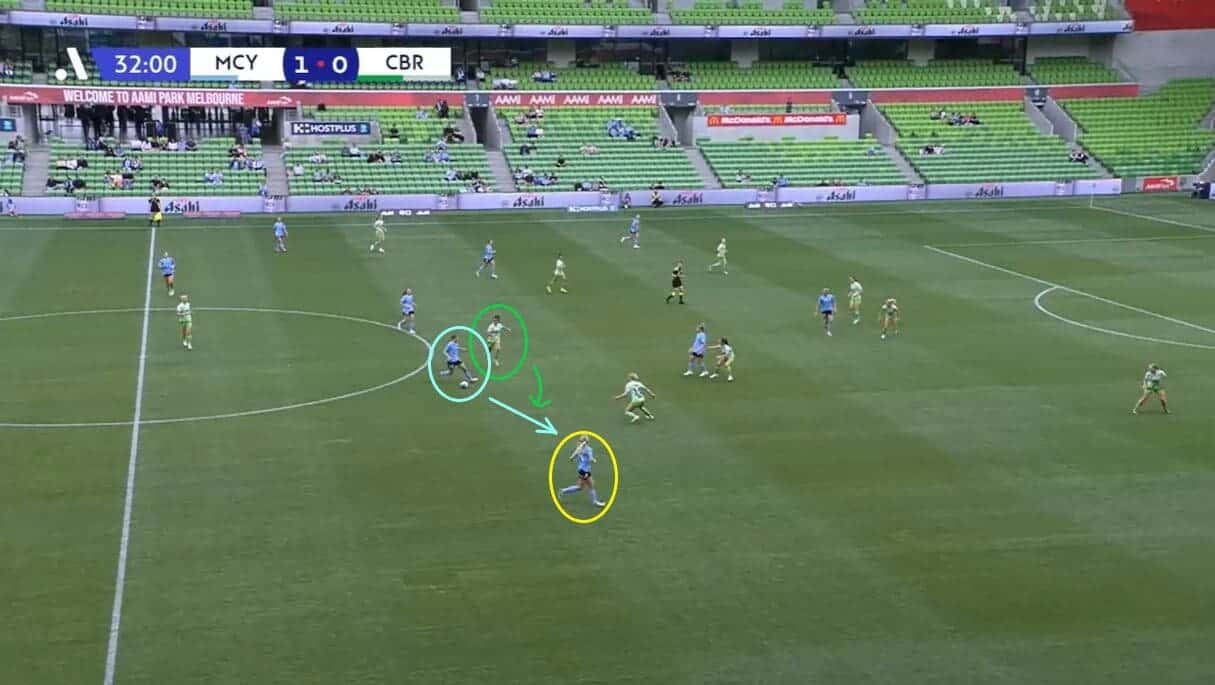
When it comes to the latter, Milivojević has tended to focus once again on winning the ball and on getting her team moving up the field. However, this is not as simple as making a tackle at the first available opportunity, and this is where the midfielder shows another side to her game, with her being patient at times and demonstrating why she has been labelled by some at the club as a “silent assassin”.
In this case, Melbourne City Women, who have been one of the league’s early pace-setters, have looked to move up the field through New Zealand defender Rebekah Stott, who has dribbled beyond the halfway line and is now looking for a pass. Milivojević is waiting nearby but doesn’t immediately attempt to tackle the former Brighton and Hove Albion Women centre-back, with her instead tracking her and trying to limit her passing options.
It has the desired effect, with Stott passing across the pitch towards right-back Kaitlyn Torpey, allowing Canberra to instigate their press and halt Melbourne’s progress. In this case, the initial move is made by winger Nikki Flannery, who gets tight to Torpey and forces the ball to be returned to Stott, and that is where Milivojević, who by then had circled around Stott, was able to make a successful interception.
What is important to note here is that Milivojević is not only looking at what is happening now but at what will happen in the next phase of each attack, and that is what leads to her winning the ball back here and averaging 5.66 interceptions per game. Therefore, when considering what she brings to the Canberra game plan, this has to be taken into consideration, and it is another reason that a potential injury absence could lead to the team from the capital struggling to break into the top four this season.
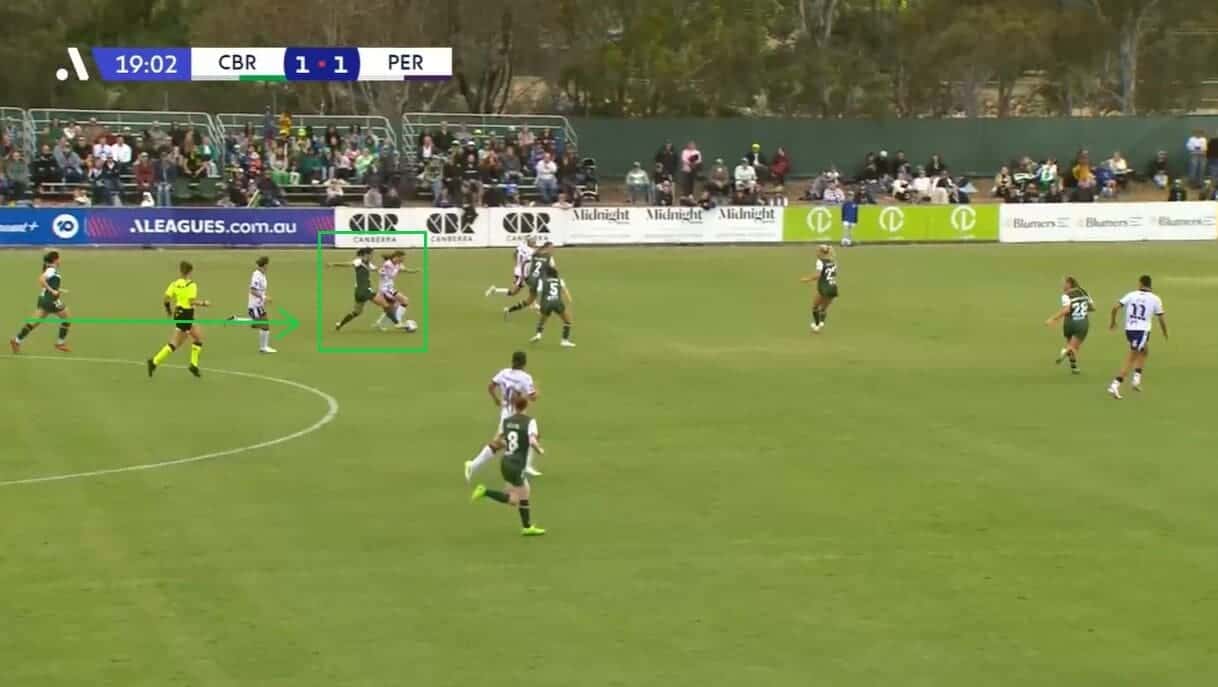
Her speed of thought in those situations is vital, but her natural speed around the field is just as important to her defensive midfield capabilities. In this case, Perth Glory Women are looking to counterattack through Grace Johnston, with the aim of moving the ball into one of their key goalscoring threats before Canberra can get back and make another interception, but Milivojević is just too quick here, and Johnston struggles to evade her clutches for too long.
There was a suspicion of a push on the Perth player here, but the fact that Milivojević is able to make clear contact with the ball is what does need to be mentioned because it would have been easy for her to concede a foul here and to leave her side trying to defend a set piece in a dangerous position. As it turned out, that eventuality didn’t happen, and Canberra were instead able to end the threat and move the ball up the field, which was vital given that Perth currently sit at the league’s summit. It would not have been possible, though, without the determination shown by Milivojević.
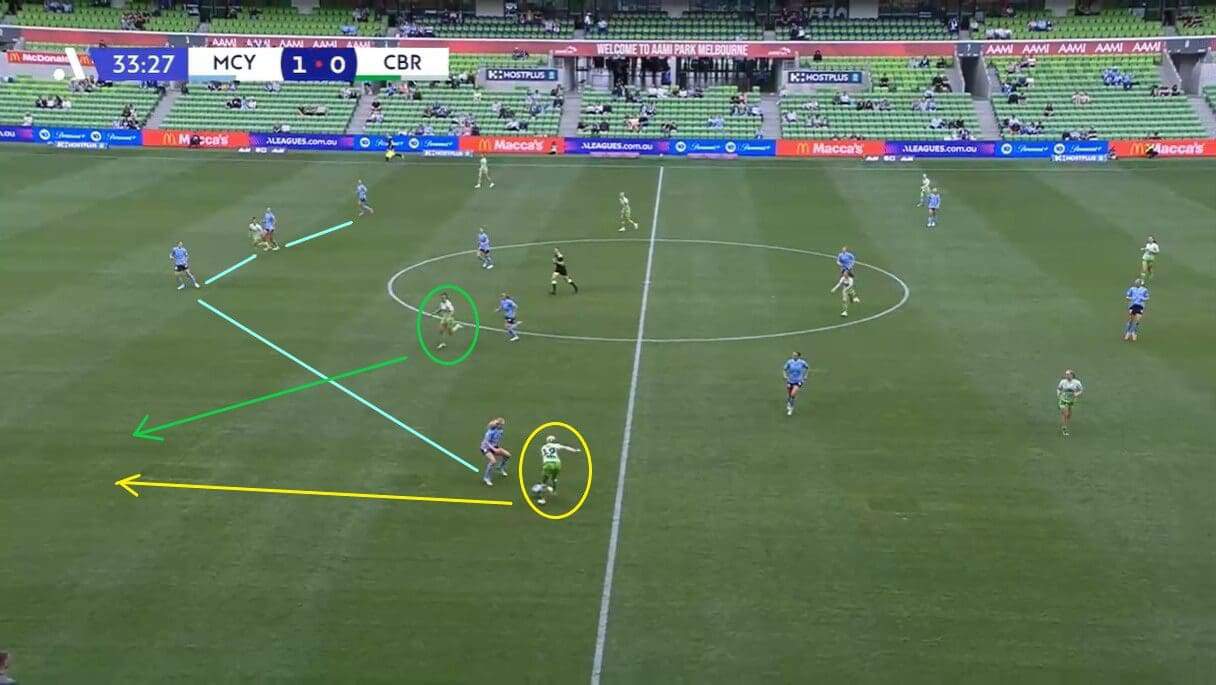
When Canberra are in possession, Milivojević’s midfield responsibilities turn towards instigating quick transitions through her ability to identify space and to give her side passing options as they try to move the ball up the field, and what really helps in this is the way that she combines with those in the wide areas to create numerical overloads.
In this case, the threat that creates is clear, with Melbourne losing possession and coming out to win the ball through Torpey but not drifting across to cover the gap behind her and instead leaving a sizeable gap between the right-back and the rest of the defensive line. This is not new in their play, with it being a fundamental weakness of theirs last season, too and something that continuously gave them problems inside their own third, and it is something that players like Milivojević do not need a second invitation to use against them.
However, successfully exploiting the gap relies on her teaming up with someone else to take Torpey out of the game, and that someone on this occasion is Flannery, who has been closed down by Torpey but who reads the run that Milivojević will make, and so sends the ball beyond the right-back for the midfielder to get on the end of.
On this occasion, it doesn’t lead to anything as Torpey makes a remarkable recovery to prevent a shot from being taken, but the way that Milivojević and Flannery linked up here is the critical detail to look at, with it not being the first time that the former has used teammates in the wide channels in order to punish opposing defensive mistakes.
Defensive qualities
Whilst the analysis so far has focused predominantly on what Vesna Milivojević offers in the midfield and attacking areas of the pitch, there is a lot that she brings to her team’s performances inside her own third, too, and this is what makes her such a dynamic and well-rounded player and someone that Canberra United have really come to rely on in the last year.
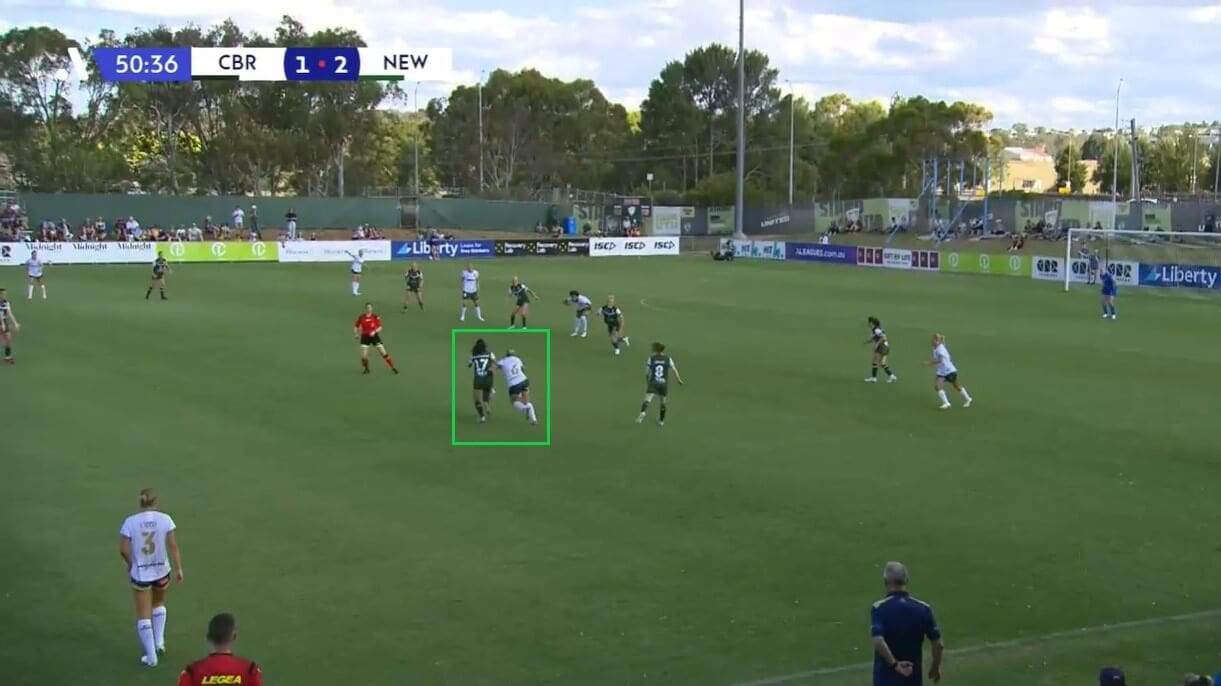
It has already been mentioned that Milivojević is capable of and does track back to help her team out whenever the ball is out of their possession and is being transferred through the midfield, but it is important to note that her defensive brief does not end there, with her often chasing balls back into her own third as she seeks to help her side be as robust as possible whenever they do have their backs against the wall.
This is one of those situations when she has needed to persevere in regaining possession for her side with Newcastle. This team have players like Allan and Philippines forward Sarina Bolden, who can hurt opposing defensive lines. With that in mind, the fact that Davis has taken the ball deep into the Canberra half is a concern, as is the fact that Sasha Grove has already failed to end her forward momentum.
However, the presence of Milivojević instantly improves matters, with her getting tight to Davis and giving the back line the protection they need. The fact that she wins this defensive duel and has succeeded in 67.3% of them is one of the main reasons that Canberra rely on her just as much in these areas as they do whenever she is making runs into the final third.
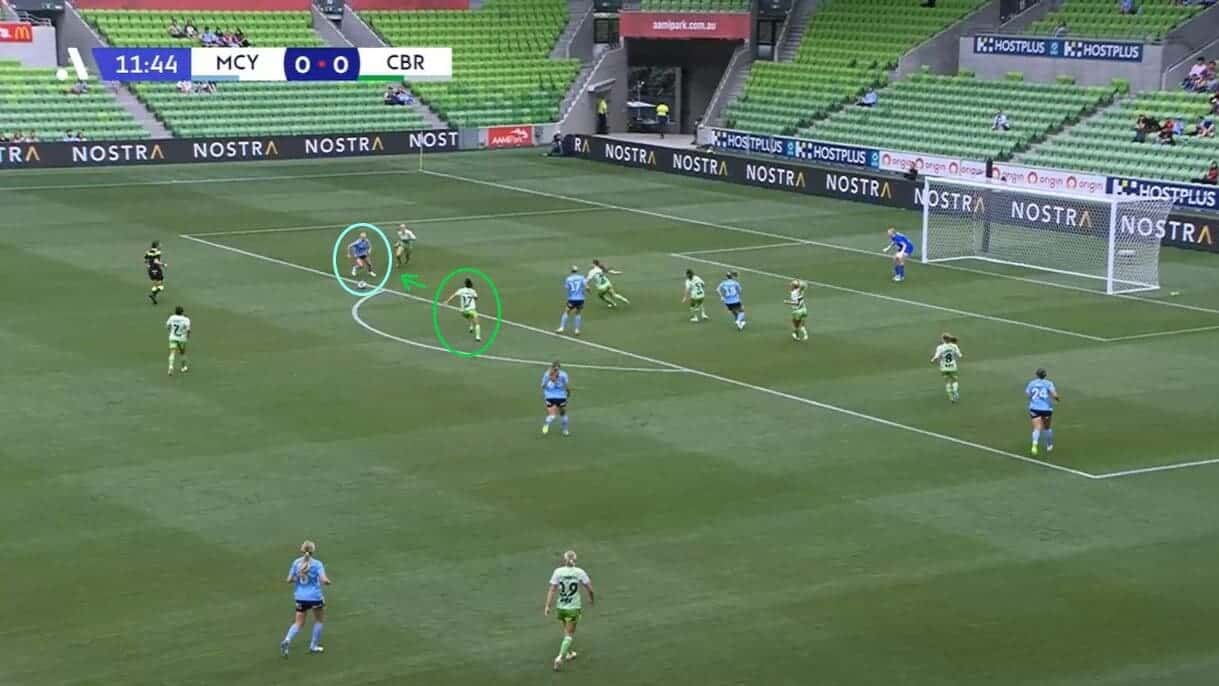
The essential quality that enables the midfielder to be so productive in winning these battles is her aforementioned anticipation and ability to read what is and what will happen around the field. In this case, Canberra are once again under pressure and are trying to limit the threat posed by Melbourne forward Holly McNamara, with Emma Ilijoski dropping back to allow right-back Tegan Bertolissio to move out and to slow her down.
However, where McNamara was really good this season, before her season-ending injury, was that she could make quick changes of direction and could cut inside onto her inside foot, giving her a better chance of finding the back of the net, and that has happened here too as Bertolissio has moved out just too much and has been taken out of the game. However, Canberra are rescued by Milivojević sprinting across the pitch and filling the gap that McNamara had created, blocking the forward’s attempted shot and ending Melbourne’s attack.
Melbourne may have won this match, but Canberra did thwart them on several occasions, making it difficult to secure all three points. There is no doubt when breaking down situations like this that Milivojević was a key reason for that being the case.
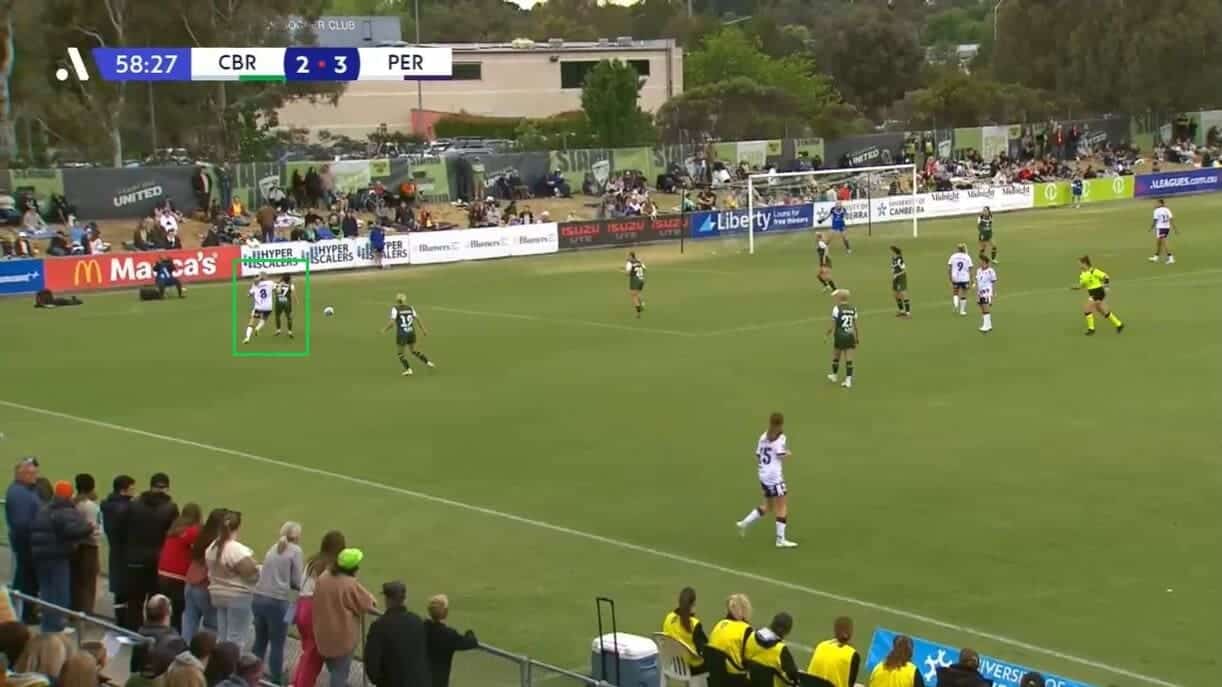
However, as has been highlighted previously in the scout report, Milivojević does not stop when the ball leaves her vicinity and is instead a player who will work hard for her team regardless of where she and the ball are on the pitch. Here, she has ended up following Perth’s Hana Lowry into the area behind the Canberra back line and has got her body between her and the ball, preventing Lowry from getting a shot away at goal and stopping what would ordinarily have been a simple delivery into the middle of the goal area.
As a result of the attack being slowed down, the Canberra players can now react and track back to close off the avenues behind them, making it doubly difficult for Perth to create anything from this move. In the end, that wasn’t needed because Milivojević managed to put the ball out of play for a throw-in, and it shows how formidable she is and how she is a player who never stops working until the ball is safe.
Conclusion
In conclusion, this tactical analysis has looked in detail at Canberra United midfielder Vesna Milivojević, who has started the season in fine form and who has really established herself as one of the best players in the A-League Women. The analysis has highlighted the impact that she has made in attack, midfield and defence and has shown how her game has developed during her time at Canberra as she has increased the range of things that she can offer on the field.
Such has been the quality of her performances so far; there have been questions from some around Australia as to whether she would be eligible for a call-up to their national team, with her born in the country. However, she has already committed to the Serbia team and has featured during the recent Women’s Nations League matches for them, alongside the likes of Chelsea Women midfielder Jelena Čanković, Bayern Munich Frauen forward Jovana Damnjanović and Fiorentina Femminile playmaker Milica Mijatović (who has been one of Serie A Femminile’s most in-form players this season) as the Balkan nation sealed a promotion playoff match in the race to progress up to League B.
As referenced throughout the analysis, the midfielder was forced off early at the weekend, and there are concerns that it could be an ACL injury, which would end her season. Nothing has been confirmed or denied as things stand, and fans are facing a nervous wait over the issue. It has been clear from the points made that her being out of action could be highly damaging to Canberra’s hopes of making the playoffs.





Comments